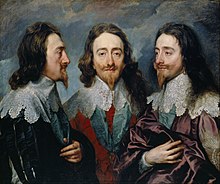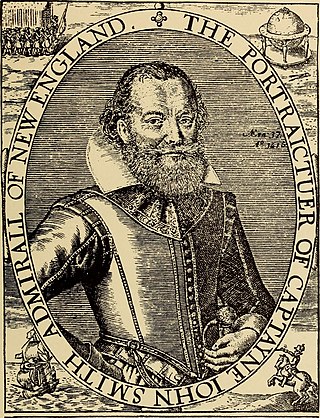
John Smith was an English soldier, explorer, colonial governor, admiral of New England, and author. He played an important role in the establishment of the colony at Jamestown, Virginia, the first permanent English settlement in North America, in the early 17th century. He was a leader of the Virginia Colony between September 1608 and August 1609, and he led an exploration along the rivers of Virginia and the Chesapeake Bay, during which he became the first English explorer to map the Chesapeake Bay area. Later, he explored and mapped the coast of New England. He was knighted for his services to Sigismund Báthory, Prince of Transylvania, and his friend Mózes Székely.
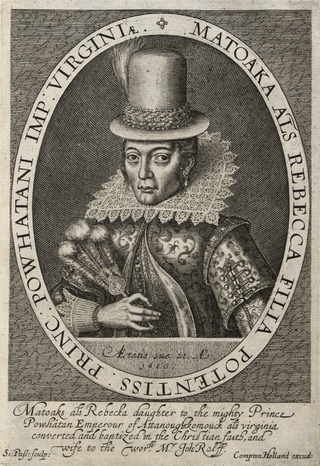
Pocahontas was a Native American woman, belonging to the Powhatan people, notable for her association with the colonial settlement at Jamestown, Virginia. She was the daughter of Powhatan, the paramount chief of a network of tributary tribes in the Tsenacommacah, encompassing the Tidewater region of Virginia.

Pocahontas is a 1995 American animated musical historical drama film based on the life of Powhatan woman Pocahontas and the arrival of English colonial settlers from the Virginia Company. The film romanticizes Pocahontas' encounter with John Smith and her legendary saving of his life. The film was produced by Walt Disney Feature Animation and released by Walt Disney Pictures. It is the 33rd Disney animated feature film and the sixth film produced and released during the Disney Renaissance.

Edith Wilson was the first lady of the United States from 1915 to 1921 and the second wife of President Woodrow Wilson. She married the widower Wilson in December 1915, during his first term as president. Edith Wilson played an influential role in President Wilson's administration following the severe stroke he suffered in October 1919. For the remainder of her husband's presidency, she managed the office of the president, a role she later described as a "stewardship", and determined which communications and matters of state were important enough to bring to the attention of the bedridden president.

The Powhatan people may refer to any of the indigenous Algonquian people that are traditionally from eastern Virginia. All of the Powhatan groups descend from the Powhatan Confederacy. In some instances, The Powhatan may refer to one of the leaders of the people. This is most commonly the case in historical records from English colonial accounts. The Powhatans have also been known as Virginia Algonquians, as the Powhatan language is an eastern-Algonquian language, also known as Virginia Algonquian. It is estimated that there were about 14,000–21,000 Powhatan people in eastern Virginia, when English colonists established Jamestown in 1607.

Opechancanough was paramount chief of the Powhatan Confederacy in present-day Virginia from 1618 until his death. He had been a leader in the confederacy formed by his older brother Powhatan, from whom he inherited the paramountcy.

Fashion in the years 1750–1775 in European countries and the colonial Americas was characterised by greater abundance, elaboration and intricacy in clothing designs, loved by the Rococo artistic trends of the period. The French and English styles of fashion were very different from one another. French style was defined by elaborate court dress, colourful and rich in decoration, worn by such iconic fashion figures as Marie Antoinette.
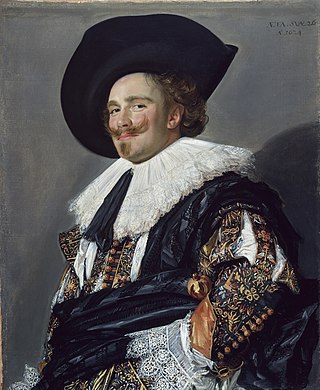
Fashion in the period 1600–1650 in Western European clothing is characterized by the disappearance of the ruff in favour of broad lace or linen collars. Waistlines rose through the period for both men and women. Other notable fashions included full, slashed sleeves and tall or broad hats with brims. For men, hose disappeared in favour of breeches.

A lock of hair is a piece or pieces of hair that has been cut from, or remains singly on, a human head, most commonly bunched or tied together in some way. A standard dictionary definition defines a lock as a tress, curl, or ringlet of hair.
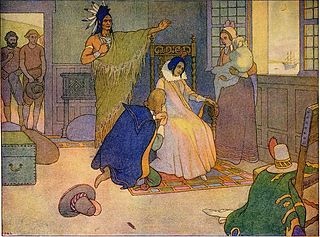
Uttamatomakkin was a Powhatan holy man who accompanied Pocahontas when she was taken to London in 1616.
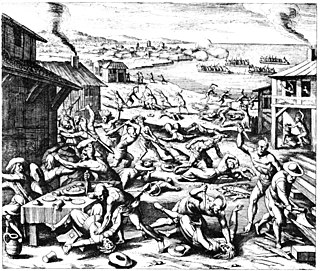
The Anglo–Powhatan Wars were three wars fought between settlers of the Virginia Colony and Algonquin Indians of the Powhatan Confederacy in the early seventeenth century. The first war started in 1609 and ended in a peace settlement in 1614. The second war lasted from 1622 to 1632. The third war lasted from 1644 until 1646 and ended when Opechancanough was captured and killed. That war resulted in a defined boundary between the Indians and colonial lands that could only be crossed for official business with a special pass. This situation lasted until 1677 and the Treaty of Middle Plantation which established Indian reservations following Bacon's Rebellion.
Pocahontas is the titular character of Walt Disney Pictures' 33rd animated feature film Pocahontas (1995). The character and the events she goes through are loosely based on the actual historical figure Pocahontas, making her the first Disney Princess not to be based on a fairytale or folktale but rather a real historical figure. She is also the first to technically not be a princess, as she is not of royalty nor does she marry into royalty. She is, however, a Chieftain's daughter, which can arguably be the equivalent of a princess.
The Vision of Delight was a Jacobean era masque written by Ben Jonson. It was most likely performed on Twelfth Night, 6 January 1617 in the Banqueting House at Whitehall Palace, and repeated on 19 January that year.

Carolina Algonquian was an Algonquian language of the Eastern Algonquian subgroup formerly spoken in North Carolina, United States. Carolina Algonquian was formerly spoken by Secotan, Chowanoke and Weapemeoc peoples.

The Kashmir shawl, the predecessor of the contemporary cashmere shawl, is a type of shawl identified by its distinctive Kashmiri weave and for being made of fine shahtoosh or pashmina wool. Contemporary variants include the pashmina and shahtoosh shawls. In the late 20th century, they evolved to middle-class popularity through generic cashmere products, and raffal, shawls woven in the Kashmiri style, but using thicker Merino wool. Originally designed as a covering for men in India, it has evolved in the popular cultures of India, Europe, and the United States as indicators of nobility and rank, heirlooms giving on a girl's coming-of-age and marriage, and subsequently, as artistic elements in interior design.
The Medieval period in England is usually classified as the time between the fall of the Roman Empire to the beginning of the Renaissance, roughly the years AD 410–1485. For various peoples living in England, the Anglo-Saxons, Anglo-Danes, Normans and Britons, clothing in the medieval era differed widely for men and women as well as for different classes in the social hierarchy. The general styles of Early medieval European dress were shared in England. In the later part of the period, men's clothing changed much more rapidly than women's styles. Clothes were very expensive and both the men and women of lower social classes continued also divided social classes by regulating the colors and styles these various ranks were permitted to wear. In the early Middle Ages, clothing was typically simple and, particularly in the case of lower-class peoples, served only basic utilitarian functions such as modesty and protection from the elements. As time went on the advent of more advanced textile techniques and increased international relations, clothing gradually got more and more intricate and elegant, even with those under the wealthy classes, up into the renaissance.
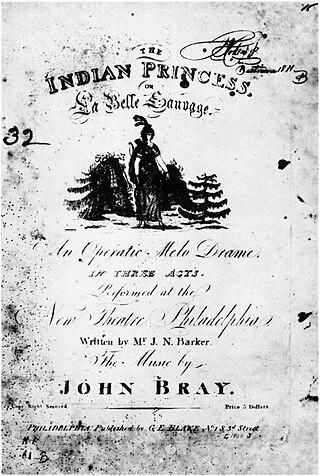
The Indian Princess; or, La Belle Sauvage, is a musical play with a libretto by James Nelson Barker and music by John Bray, based on the Pocahontas story as originally recorded in John Smith's The Generall Historie of Virginia (1621). The piece is structured in the style of a Ballad-opera, with songs and choruses, and also has music underlying dialogue, like a melodrama. Pocahontas persuades her father, King Powhatan, to free Smith and becomes attracted to John Rolfe, breaking off her arranged marriage with a neighboring tribal prince, an action that leads to war. Her tribe wins the war, but her father loses trust in the white settlers; Pocahontas warns the settlers who reconcile with Powhatan. Several comic romances end happily, and Smith predicts a great future for the new country.

The Secotans were one of several groups of American Indians dominant in the Carolina sound region, between 1584 and 1590, with which English colonists had varying degrees of contact. Secotan villages included the Secotan, Aquascogoc, Dasamongueponke, Pomeiock (Pamlico) and Roanoac. Other local groups included the Chowanoke, Weapemeoc, Chesapeake, Ponouike, Neusiok, and Mangoak (Tuscarora), and all resided along the banks of the Albemarle and Pamlico sounds. They spoke Carolina Algonquian language, an Eastern Algonquian language.

Captain John Smith and Pocahontas is a 1953 American historical western film directed by Lew Landers. The distributor was United Artists. It stars Anthony Dexter, Jody Lawrance and Alan Hale.

A kiss curl describes a lock of hair curling onto the face and usually plastered down. Although the curl could be flattened with saliva, soap or hair lotion was more typically used.
